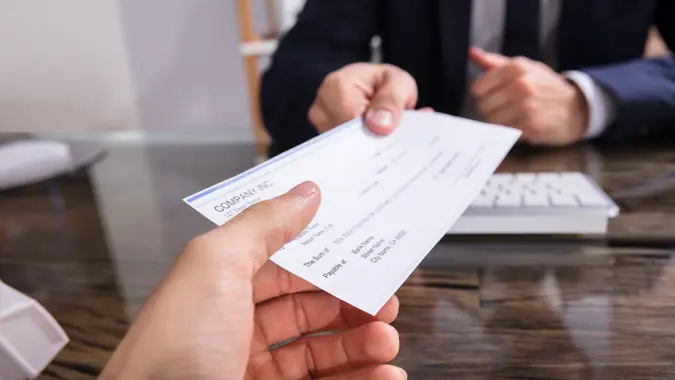Your Used Car Trade-In Is Worth A Lot Less Than You Think — Here’s What It Means For Your New Purchase

Commitment to Our Readers
GOBankingRates' editorial team is committed to bringing you unbiased reviews and information. We use data-driven methodologies to evaluate financial products and services - our reviews and ratings are not influenced by advertisers. You can read more about our editorial guidelines and our products and services review methodology.

20 Years
Helping You Live Richer

Reviewed
by Experts

Trusted by
Millions of Readers
Here’s the biggest understatement you’ll hear all day: New cars are expensive! However, the consolation in buying a new vehicle, the trade-in, is increasingly worth less as the U.S. economy continues to struggle.
According to the Detroit Free Press, used car values have decreased as inventory remains stagnant and prices continue to rise. With lenders seeing consumers fall behind on their loan payments more often, new buyers expecting to get high value for their trade-in may be in for a surprise.
Writing for the Detroit Free Press, Susan Tompor explained the dilemma facing new car buyers counting on bargaining down with a trade-in. Said buyers may have to grapple with “negative equity” — or owing more on your car than its worth in trade.
“The real problems pop up when someone needs to buy a new car — and doesn’t have $3,000 or $5,000 sitting on the sidelines to cover what they still owe on the car they’d like to trade in,” wrote Tompor. “You might have to take on an even bigger car loan and an even bigger monthly payment to get another set of wheels.”
According to data from Edmunds, the average amount financed for a new car in January 2019 was $31,707. In May 2023, the average amount financed for new cars was $40,381, up 27%. For used cars, the average amount financed was $29,736 in May — that’s more than 36% from an average of $21,763 in January 2019, per the Detroit Free Press.
Over the past four years, buyers have been hit with heftier loan rates, too. The average car loan rates for new and used vehicles were 7.1% and 11% in May 2023, respectively, up from 6.2% and 8.9% in January 2019.
Loan rates and payments are especially taxing on those who bought used cars as prices and interest were at their highest point — and because it was a necessity. “They often go and purchase a vehicle because they really need it,” Satyan Merchant, senior vice president of the auto business at TransUnion, told the Detroit Free Press.
How To Boost the Value of Your Used Car
With the exception of high-performance sports cars as well as vintage and rare vehicles, most cars depreciate in value quickly from lot to home. In fact, cars can drop 20%-30% in the first year of ownership and 60% or more after five years.
How you treat your vehicle can put thousands of extra dollars in your pocket when the time come to trade it in for a new purchase. Getting more for your trade-in means you’ll have less to finance. Doing so can save you money over the course of your loan.
Here’s 5 ways to increase the value of your car:
1. Service Your Car
The simplest way to increase your car’s value is to take good care of it. Regularly maintaining your vehicle and keeping all service records will make a difference. Buyers, especially dealerships, will pay more for a car that is cared for.
And if you’re saying your car is in good shape, prove it. A dealership will know what state your car really is in, so provide a vehicle history report showing that there are no major issue or existing damage concerns.
2. Don’t Drive Your Car Any More Than Necessary
Simply put, low mileage cars are worth more than those driven hard or more often. According to the Department of Transportation, the average miles driven per year is 13,476 (2022), so trading in a car with less than the average mileage on it will net you more equity. Age matters, too. The newer the trade-in, the bigger the profit a dealer can make — and the more you’re likely to be offered.
3. Consider What Equipment Your Car Needs When You First Buy It
Some pieces of standard and optional equipment are more prized than others. For example, more Americans drive vehicles with automatic transmissions than with manual ones — and dealerships want used cars that will attract more buyers. So, a stick shift might not command as much on a trade-in as an automatic vehicle, despite being rarer.
As Capital One noted: “Other pluses at trade-in time are upgraded factory audio systems, automatic climate control, power seats, upgraded upholstery, and sunroofs.”
4. Shop Your Car Around for Trade-in
Talk to as many dealers as you can to get the best offer for your used trade-in. Think of your trade-in as you did when you bought it — as an investment — and make a convincing case when trading in.
5. Detail Your Car Before Trading it In
Common sense dictates that if something looks good, it will be worth more. Cleanliness equals care and you should put the work in to keep both the outside and interior as tidy as possible. This means repairing/replacing any damaged small components and getting rid or trash, stains and odors. If you can’t do it yourself, spend the money on a professional detailing service.
 Written by
Written by  Edited by
Edited by 

























